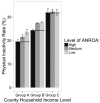Association between Natural Resources for Outdoor Activities and Physical Inactivity: Results from the Contiguous United States
- PMID: 27548195
- PMCID: PMC4997516
- DOI: 10.3390/ijerph13080830
Association between Natural Resources for Outdoor Activities and Physical Inactivity: Results from the Contiguous United States
Abstract
Protected areas including national/state parks and recreational waters are excellent natural resources that promote physical activity and interaction with Nature, which can relieve stress and reduce disease risk. Despite their importance, however, their contribution to human health has not been properly quantified. This paper seeks to evaluate quantitatively how national/state parks and recreational waters are associated with human health and well-being, taking into account of the spatial dependence of environmental variables for the contiguous U.S., at the county level. First, we describe available natural resources for outdoor activities (ANROA), using national databases that include features from the Protected Areas Database, NAVSTREETS, and ATTAINSGEO 305(b) Waters. We then use spatial regression techniques to explore the association of ANROA and socioeconomic status factors on physical inactivity rates. Finally, we use variance analysis to analyze ANROA's influence on income-related health inequality. We found a significantly negative association between ANROA and the rate of physical inactivity: ANROA and the spatial effect explained 69%, nationwide, of the variation in physical inactivity. Physical inactivity rate showed a strong spatial dependence-influenced not only by its own in-county ANROA, but also by that of its neighbors ANROA. Furthermore, community groups at the same income level and with the highest ANROA, always had the lowest physical inactivity rate. This finding may help to guide future land use planning and community development that will benefit human health and well-being.
Keywords: community health; physical inactivity; protected areas; spatial autocorrelation; spatial lag model.
Figures




Similar articles
-
Association of outdoor recreation availability with physical activity and weight status in Minnesota youth.Prev Med. 2014 Mar;60:124-7. doi: 10.1016/j.ypmed.2013.11.010. Epub 2013 Nov 18. Prev Med. 2014. PMID: 24262972
-
Geographical Variations in the Environmental Determinants of Physical Inactivity among U.S. Adults.Int J Environ Res Public Health. 2017 Oct 31;14(11):1326. doi: 10.3390/ijerph14111326. Int J Environ Res Public Health. 2017. PMID: 29088093 Free PMC article.
-
Tract- and county-level income inequality and individual risk of obesity in the United States.Soc Sci Res. 2016 Jan;55:75-82. doi: 10.1016/j.ssresearch.2015.09.008. Epub 2015 Oct 3. Soc Sci Res. 2016. PMID: 26680289 Free PMC article.
-
Predictors of physical health: toward an integrated model of genetic and environmental antecedents.J Gerontol B Psychol Sci Soc Sci. 2005 Mar;60 Spec No 1:42-52. doi: 10.1093/geronb/60.special_issue_1.42. J Gerontol B Psychol Sci Soc Sci. 2005. PMID: 15863709 Review.
-
Recreational exercise in arthritis.Rheum Dis Clin North Am. 1996 Aug;22(3):563-77. doi: 10.1016/s0889-857x(05)70288-x. Rheum Dis Clin North Am. 1996. PMID: 8844914 Review.
Cited by
-
The Role of Nutrition and Forest-Bathing in the Physical Rehabilitation of Physically Inactive Patients: From the Molecular Aspects to New Nature-Inspired Techniques.Int J Environ Res Public Health. 2022 Dec 31;20(1):793. doi: 10.3390/ijerph20010793. Int J Environ Res Public Health. 2022. PMID: 36613115 Free PMC article. Review.
-
Varying age-gender associations between body mass index and urban greenspace.Urban For Urban Green. 2017 Aug;26:1-10. doi: 10.1016/j.ufug.2017.05.016. Epub 2017 Jun 3. Urban For Urban Green. 2017. PMID: 29225562 Free PMC article.
-
Protected Natural Areas: In Sickness and in Health.Int J Environ Res Public Health. 2018 Oct 6;15(10):2182. doi: 10.3390/ijerph15102182. Int J Environ Res Public Health. 2018. PMID: 30301212 Free PMC article.
References
-
- World Health Organization (WHO) Physical Inactivity: A Global Public Health Problem. World Health Organization; Geneva, Switzerland: 2011.
-
- World Health Organization (WHO) Global Status Report on Noncommunicable Diseases. WHO; Geneva, Switzerland: 2010. [(accessed on 10 August 2016)]. Burden: Mortality, morbidity and risk factors. Available online: http://www.who.int/nmh/publications/ncd_report_chapter1.pdf.
MeSH terms
LinkOut - more resources
Full Text Sources
Other Literature Sources
Medical

